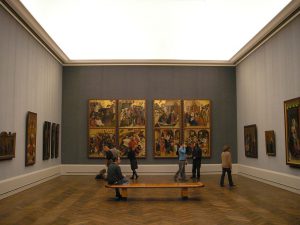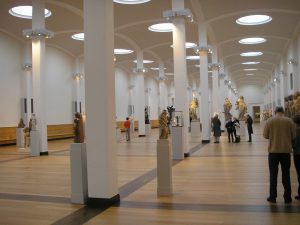The Gemäldegalerie in Berlin: Seventy-two rooms of outstanding art
By Tracy A. Burns
 The Gemäldegalerie (Old Master Paintings) in Berlin boasts one of the world’s premier collections of European art from the beginning of medieval painting in the 13th century up to Neoclassicism, ending around 1800. The museum houses the best collection of German art in the world as well as outstanding Early Netherlandish and Italian paintings. Rembrandt’s works take up an entire room, where visitors can gaze at one of the largest collections of that artist’s paintings. In another space, viewers can compare five different Madonnas by Raphael. The main galleries show off about 850 works, and there are about 400 more paintings downstairs in the study galleries. Seventy-two rooms of art are sure to dazzle museumgoers.
The Gemäldegalerie (Old Master Paintings) in Berlin boasts one of the world’s premier collections of European art from the beginning of medieval painting in the 13th century up to Neoclassicism, ending around 1800. The museum houses the best collection of German art in the world as well as outstanding Early Netherlandish and Italian paintings. Rembrandt’s works take up an entire room, where visitors can gaze at one of the largest collections of that artist’s paintings. In another space, viewers can compare five different Madonnas by Raphael. The main galleries show off about 850 works, and there are about 400 more paintings downstairs in the study galleries. Seventy-two rooms of art are sure to dazzle museumgoers.
History of the collection
The Gemäldegalerie was inaugurated in 1830. During World War II many of its paintings were stored in the Thuringian salt mines. American forces dramatically rescued some 1,225 workers from these mines. About 1,000 more works were preserved in air raid shelters during the war. For many decades the collection was split into West and East Berlin at the Bode Museum and Dahlem Museum. In 1998 they were merged into one building, located in the Kulturforum museum district.
The German collection
Some highlights of the German collection include works by Albrecht Dürer and Lucas Cranach the Elder. In Dürer’s portrait of Hieronymus Holzschuher (1526), one of the most significant works of the artist’s late period, Holzschuher stares intently at the viewer, both critical and curious. One of the many notable works by Lucas Cranach the Elder is The Fountain of Youth (1546), which focuses on a fountain in a pool. Elderly women emerge from rocky terrain and enter the water from the left-hand side. When they step out of the pool on the right-hand side, they regain their youthful features. Venus and Cupid make appearances on the fountain, too.
The Netherlandish collection
 The Netherlandish collection that has earned much acclaim includes Pieter Bruegel the Elder’s Dutch Proverbs (1559), in which the artist painted realistic scenes illustrating 100 proverbs in a village near the sea. The artist draws the viewer’s attention to spiritual and moral concerns. One of the many masterpieces by Peter Paul Rubens is Child with a Bird (1624-25), in which he portrays a spontaneous moment. The child resembles an angel or putti figure. In Frans Hals’ Singing Boy with Flute (1623-25), the happy boy is delighted by the music his flute produces. The scene is captured in dramatic lighting. Notice the youth’s elaborate costume. Emotion and spontaneity flow from Hals’ Malle Babe (1633-35): An owl has perched on the shoulder of a drunk, elderly, disturbed woman who is laughing madly.
The Netherlandish collection that has earned much acclaim includes Pieter Bruegel the Elder’s Dutch Proverbs (1559), in which the artist painted realistic scenes illustrating 100 proverbs in a village near the sea. The artist draws the viewer’s attention to spiritual and moral concerns. One of the many masterpieces by Peter Paul Rubens is Child with a Bird (1624-25), in which he portrays a spontaneous moment. The child resembles an angel or putti figure. In Frans Hals’ Singing Boy with Flute (1623-25), the happy boy is delighted by the music his flute produces. The scene is captured in dramatic lighting. Notice the youth’s elaborate costume. Emotion and spontaneity flow from Hals’ Malle Babe (1633-35): An owl has perched on the shoulder of a drunk, elderly, disturbed woman who is laughing madly.
Jan Vermeer van Delft
Even though Jan Vermeer van Delft produced only 35 paintings, several can be seen at the Gemäldegalerie, including his highly touted Young Woman with a Pearl Necklace. Vermeer uses color in a brilliant manner as he takes up the theme of showing ordinary people doing everyday things. Jacob van Ruisdael, the guru of Dutch landscape painting, is represented, too.
Rembrandt van Rijn
Try not to be overwhelmed by the room filled with Rembrandt’s masterpieces. For instance, focus on Moses with the Ten Commandments (1659). Feel the wrath and inner turmoil of Moses, who is about to destroy the tablets. Appreciate the details – the inscriptions on the tablets are accurate.
Botticelli and Raphael
Sandro Botticelli’s works are also on display. Notice the plant ornamentation in Madonna with Saints (1484-85). In Mary with the Child and Singing Angels (1477), take note of the masterfully rendered lilies that the singing angels are holding. Raphael’s Madonna Colonna from 1508 is the epitome of elegance while the landscape is graceful.
Titian and Caravaggio
Don’t miss the Portrait of Clarissa Strozzi at the Age of Two, rendered by Titian in 1542. It is one of the earliest portraits of a child in Italian painting. A definite highlight for the Caravaggio fan in particular and for the European Baroque admirer, in general, is Cupid As Victor (1601-02), which shows Cupid victorious over science, powers, art, and fame. He knows he’s victorious – just look at the grin on his face! Caravaggio’s use of chiaroscuro is spectacular.
Yet those are just a few examples of the artists and works represented at the Gemäldegalerie. Other exceptional paintings in the building were rendered by Diego Velázquez, Nicolas Poussin, Antoine Watteau, Hans Holbein, Rogier van der Weyden, Jan van Eyck, and Fra Angelico, Hans Multscher, and Masaccio. If you are pressed for time, you can take a day trip from Prague to check out a few galleries. The Gemäldegalerie will not disappoint.



